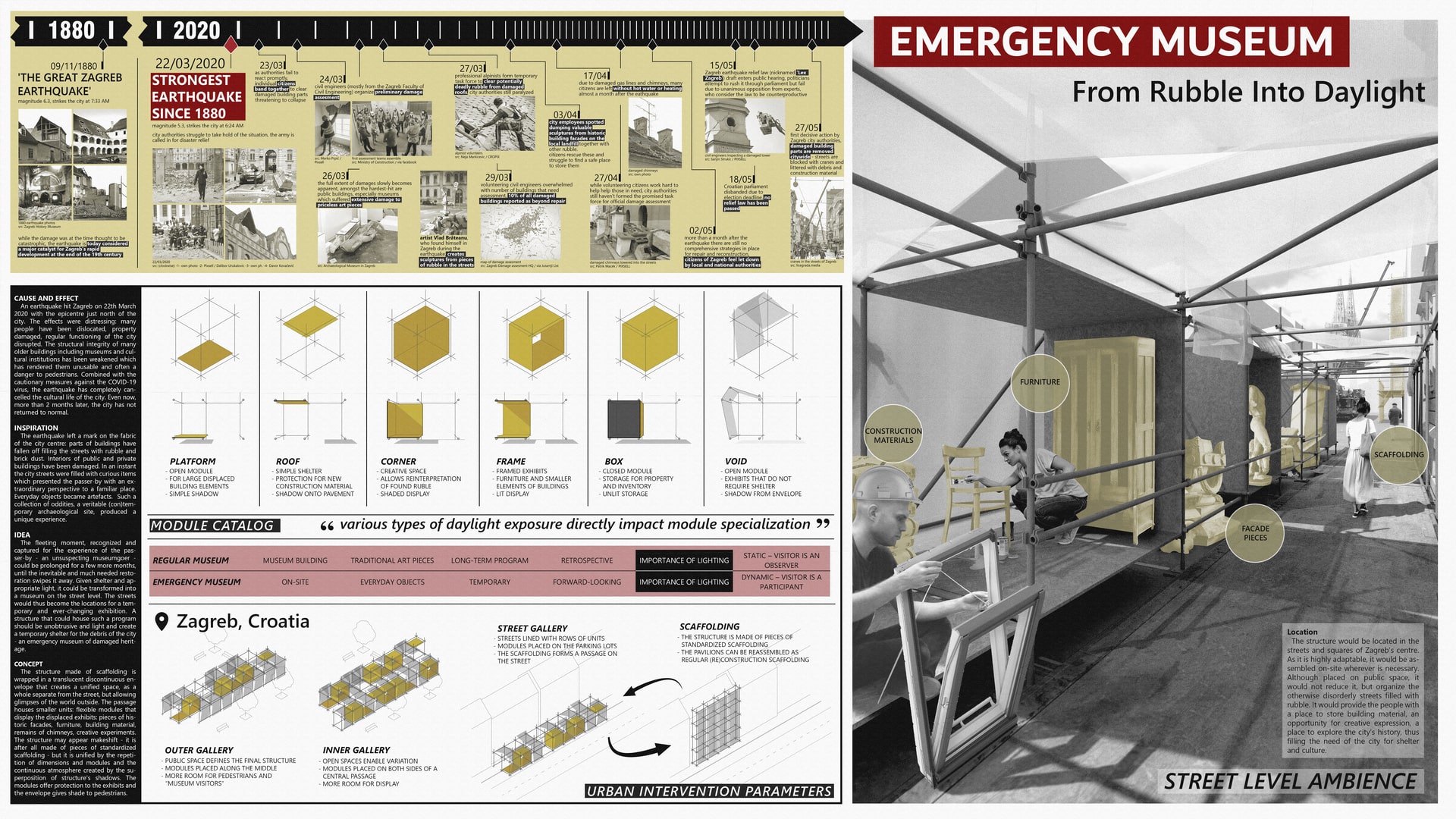Project Description
Emergency Museum Cause and Effect An earthquake hit Zagreb on 22th March 2020 with the epicentre just north of the city. The effects were distressing: many people have been dislocated, property damaged, regular functioning of the city disrupted. The structural integrity of many older buildings including museums and cultural institutions has been weakened which has rendered them unusable and often a danger to pedestrians. Combined with the cautionary measures against the COVID-19 virus, the earthquake has completely cancelled the cultural life of the city. Even now, more than 2 months later, the city has not returned to normal. Inspiration The earthquake left a mark on the fabric of the city centre: parts of buildings have fallen off filling the streets with rubble and brick dust. Interiors of public and private buildings have been damaged. In an instant the city streets were filled with curious items which presented the onlooker with an extraordinary perspective to a familiar place. Everyday objects became artefacts. Such a collection of oddities, a veritable (con)temporary archaeological site, produced a unique experience. Idea The fleeting moment, recognized and captured for the experience of the passer-by – an unsuspecting museumgoer – could be prolonged for a few more months, until the inevitable and much needed restoration swipes it away. Given shelter and appropriate light, it could be transformed into a museum on the street level. The streets would thus become the locations for a temporary and ever-changing exhibition. A structure that could house such a program should be unobtrusive and light and create a temporary shelter for the debris of the city – an emergency museum of damaged heritage. Concept The basic structure is made of scaffolding which creates a frame for the exhibition. Inside, smaller modules for exhibits are inserted next to an open passage for pedestrians. The structure is temporary – when it becomes necessary, it is dismantled and reused as a regular (re)construction scaffolding. It is wrapped in a translucent discontinuous envelope that creates a unified space, as a whole separate from the street, but allowing glimpses of the world outside. The gallery comprises of flexible modules that display the displaced exhibits: pieces of historic facades, furniture, building material, remains of chimneys, creative experiments. The structure may appear makeshift – it is after all made of pieces of standardized scaffolding – but it is unified by the repetition of dimensions and modules and the continuous atmosphere created by the superposition of the structure's shadows. The modules offer protection to the exhibits and the envelope gives shade to pedestrians. Location The structure would be located in the streets and squares of Zagreb’s centre. As it is highly adaptable, it would be assembled on-site wherever is necessary. Although placed on public space, it would not reduce it, but organize the otherwise disorderly streets filled with rubble. It would provide the people with a place to store building material, an opportunity for creative expression, a place to explore the city’s history, thus filling the need of the city for shelter and culture. Variants The modules vary according to the item on display but the repetition and shadow create a continuous experience. Simple modules – platform and roof – allow for basic display and give shelter to elements of buildings. A corner provides space for experiments with rubble, a frame protects smaller exhibits and a box offers safe storage. The items’ place, however, changes according to their size and importance – the application of modules is kept fluid. As in a museum, the gallery in the street receives light from different directions – from above or from a side – either directly or diffused. The changing envelope and the differently shaped modules produce varying and dynamic shadows on the passage beneath. Multiplication The modules connect in rows of varying length. The structure thus formed can be placed on the street – next to a building – or it can be freestanding on a larger public space. Streets would therefore be lined with simple rows of units with modules placed on the parking lots and the scaffolding forming a passage on the pavement. Squares offer more space for storage or display so another row of modules can be added, depending on the need for display and open spaces.
